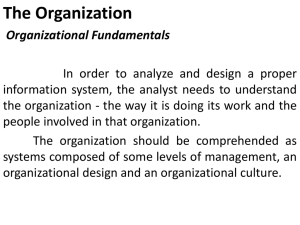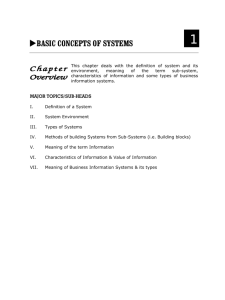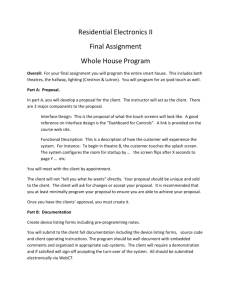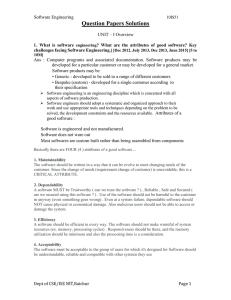Architectural Design Objectives
advertisement
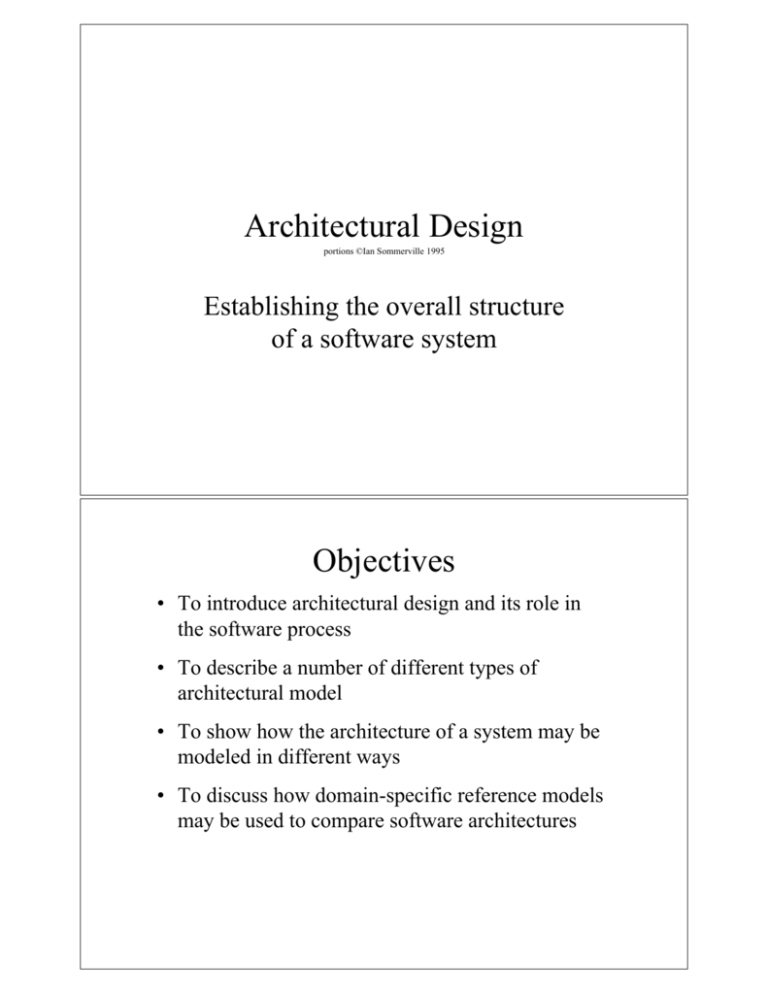
Architectural Design portions ©Ian Sommerville 1995 Establishing the overall structure of a software system Objectives • To introduce architectural design and its role in the software process • To describe a number of different types of architectural model • To show how the architecture of a system may be modeled in different ways • To discuss how domain-specific reference models may be used to compare software architectures Topics covered • System structuring • Control models • Modular decomposition • Domain-specific architectures Architectural parallels • Architects are the technical interface between the customer and the contractor building the system • A bad architectural design for a building cannot be rescued by good construction; the same is true for software • There are specialist types of building and software architects • There are schools or styles of building and software architecture Architectural design process • System structuring – The system is decomposed into several principal subsystems and communications between these subsystems are identified • Control modeling – A model of the control relationships between the different parts of the system is established • Modular decomposition – The identified sub-systems are decomposed into modules Sub-systems and modules • A sub-system is a system in its own right whose operation is independent of the services provided by other sub-systems. • A module is a system component that provides services to other components but would not normally be considered as a separate system Architectural models • Structure, control and modular decomposition may be based on a particular model or architectural style • However, most systems are heterogeneous in that different parts of the system are based on different models and, in some cases, the system may follow a composite model • The architectural model used affects the performance, robustness, distributability and maintainability of the system System structuring • Concerned with decomposing the system into interacting sub-systems • The architectural design is normally expressed as a block diagram presenting an overview of the system structure • More specific models showing how sub-systems share data, are distributed and interface with each other may also be developed Packing robot control system The repository model • Sub-systems must exchange data. This may be done in two ways: – Shared data is held in a central database or repository and may be accessed by all sub-systems – Each sub-system maintains its own database and passes data explicitly to other sub-systems • When large amounts of data are to be shared, the repository model of sharing is most commonly used CASE toolset architecture Repository model characteristics • Advantages – Efficient way to share large amounts of data – Sub-systems need not be concerned with how data is produced – Centralized management e.g. backup, security, etc. – Sharing model is published as the repository schema • Disadvantages – Sub-systems must agree on a repository data model. Inevitably a compromise – Data evolution is difficult and expensive – No scope for specific management policies – Difficult to distribute efficiently Client-server architecture • Distributed system model which shows how data and processing is distributed across a range of components • Set of stand-alone servers which provide specific services such as printing, data management, etc. • Set of clients which call on these services • Network which allows clients to access servers Film and picture library Client-server characteristics • Advantages – Distribution of data is straightforward – Makes effective use of networked systems. May require cheaper hardware – Easy to add new servers or upgrade existing servers • Disadvantages – No shared data model so sub-systems use different data organization. data interchange may be inefficient – Redundant management in each server – No central register of names and services - it may be hard to find out what servers and services are available Abstract machine model • Used to model the interfacing of sub-systems • Organizes the system into a set of layers (or abstract machines) each of which provide a set of services • Supports the incremental development of subsystems in different layers. When a layer interface changes, only the adjacent layer is affected • However, often difficult to structure systems in this way Version management system Control models • Are concerned with the control flow between subsystems. Distinct from the system decomposition model • Centralized control – One sub-system has overall responsibility for control, and starts and stops other sub-systems • Event-based control – Each sub-system can respond to externally generated events from other sub-systems or the system’s environment Centralized control • A control sub-system takes responsibility for managing the execution of other sub-systems • Call-return model – Top-down subroutine model where control starts at the top of a subroutine hierarchy and moves downwards. Applicable to sequential systems • Manager model – Applicable to concurrent systems. One system component controls the stopping, starting and coordination of other system processes. Can be implemented in sequential systems as a case statement Call-return model Real-time system control Event-driven systems • Driven by externally generated events where the timing of the event is outside the control of the sub-systems which process the event • Two principal event-driven models – Broadcast models. An event is broadcast to all subsystems. Any sub-system which can handle the event may do so – Interrupt-driven models. Used in real-time systems where interrupts are detected by an interrupt handler and passed to some other component for processing • Other event driven models include spreadsheets and production systems Broadcast model • Effective in integrating sub-systems on different computers in a network • Sub-systems register an interest in specific events. When these occur, control is transferred to the sub-system which can handle the event • Control policy is not embedded in the event and message handler. Sub-systems decide on events of interest to them • However, sub-systems don’t know if or when an event will be handled Selective broadcasting Interrupt-driven systems • Used in real-time systems where fast response to an event is essential • There are known interrupt types with a handler defined for each type • Each type is associated with a memory location and a hardware switch causes transfer to its handler • Allows fast response but complex to program and difficult to validate Interrupt-driven control Modular decomposition • Another structural level where sub-systems are decomposed into modules • Two modular decomposition models covered – An object model where the system is decomposed into interacting objects – A data-flow model where the system is decomposed into functional modules which transform inputs to outputs. Also known as the pipeline model • If possible, decisions about concurrency should be delayed until modules are implemented Object models • Structure the system into a set of loosely coupled objects with well-defined interfaces • Object-oriented decomposition is concerned with identifying object classes, their attributes and operations • When implemented, objects are created from these classes and some control model used to coordinate object operations Invoice processing system Data-flow models • Functional transformations process their inputs to produce outputs • May be referred to as a pipe and filter model (as in UNIX shell) • Variants of this approach are very common. When transformations are sequential, this is a batch sequential model which is extensively used in data processing systems • Not really suitable for interactive systems Invoice processing system Domain-specific architectures • Architectural models which are specific to some application domain • Two types of domain-specific model – Generic models which are abstractions from a number of real systems and which encapsulate the principal characteristics of these systems – Reference models which are more abstract, idealized model. Provide a means of information about that class of system and of comparing different architectures • Generic models are usually bottom-up models; Reference models are top-down models Generic models • Compiler model is a well-known example although other models exist in more specialized application domains – – – – – – Lexical analyzer Symbol table Syntax analyzer Syntax tree Semantic analyzer Code generator • Generic compiler model may be organized according to different architectural models Compiler model Language processing system Reference architectures • Reference models are derived from a study of the application domain rather than from existing systems • May be used as a basis for system implementation or to compare different systems. It acts as a standard against which systems can be evaluated • OSI model is a layered model for communication systems OSI reference model Key points • The software architect is responsible for deriving a structural system model, a control model and a sub-system decomposition model • Large systems rarely conform to a single architectural model • System decomposition models include repository models, client-server models and abstract machine models • Control models include centralized control and event-driven models Key points • Modular decomposition models include data-flow and object models • Domain specific architectural models are abstractions over an application domain. They may be constructed by abstracting from existing systems or may be idealized reference models
